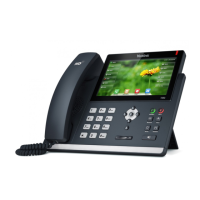Administrator’s Guide for SIP-T2 Series/T19(P) E2/T4 Series/CP860 IP Phones
2
network. Signaling allows call information to be carried across network boundaries.
Session management provides the ability to control attributes of an end-to-end call.
SIP provides capabilities to:
Determine the location of the target endpoint -- SIP supports address resolution,
name mapping, and call redirection.
Determine media capabilities of the target endpoint -- Via Session Description
Protocol (SDP), SIP determines the “lowest level” of common services between
endpoints. Conferences are established using only media capabilities that can be
supported by all endpoints.
Determine the availability of the target endpoint -- A call cannot be completed
because the target endpoint is unavailable, SIP determines whether the called
party is already on the IP phone or does not answer in the allotted number of rings.
It then returns a message indicating why the target endpoint is unavailable.
Establish a session between the origin and target endpoint -- The call can be
completed, SIP establishes a session between endpoints. SIP also supports mid-call
changes, such as the addition of another endpoint to the conference or the change
of a media characteristic or codec.
Handle the transfer and termination of calls -- SIP supports the transfer of calls from
one endpoint to another. During a call transfer, SIP simply establishes a session
between the transferee and a new endpoint (specified by the transferring party)
and terminates the session between the transferee and the transferring party. At
the end of a call, SIP terminates the sessions between all parties.
SIP is a peer-to-peer protocol. The peers in a session are called User Agents (UAs). A
user agent can function as one of following roles:
User Agent Client (UAC) -- A client application that initiates the SIP request.
User Agent Server (UAS) -- A server application that contacts the user when a SIP
request is received and that returns a response on behalf of the user.
User Agent Client (UAC)
The UAC is an application that initiates up to six feasible SIP requests to the UAS. The six
requests issued by the UAC are: INVITE, ACK, OPTIONS, BYE, CANCEL and REGISTER.
When the SIP session is being initiated by the UAC SIP component, the UAC determines
the information essential for the request, which is the protocol, the port and the IP
address of the UAS to which the request is being sent. This information can be dynamic
and will make it challenging to put through a firewall. For this reason, it may be
recommended to open the specific application type on the firewall. The UAC is also
capable of using the information in the request URI to establish the course of the SIP

